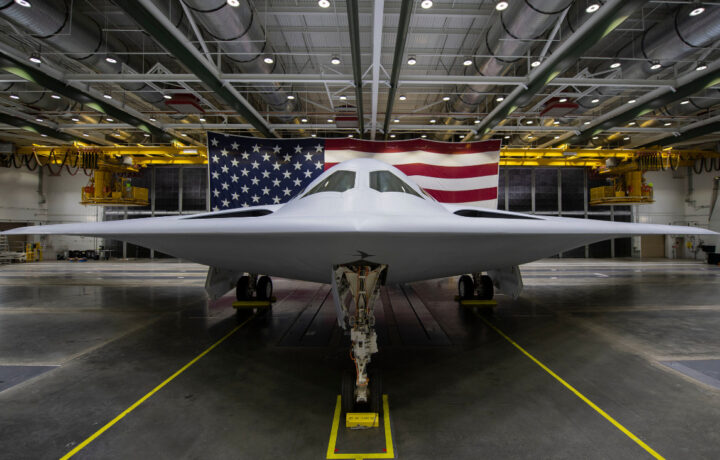Two days after the lighting of the Rockefeller Christmas Tree in New York City, there was an event that was three decades in the making at North Grumman’s facility’s in Palmdale, CA. The defense contractor and the United States Air Force officially unveiled the B-21 Raider, the first new strategic bomber to be unveiled in a generation and the first since the Northrop Grumman B-2 Spirit made its public debut back in November 1988. While similar in appearance the B-2, the Raider is actually a generational leap in aircraft technology and development.
The Raider was developed to be the multifunctional backbone of the modernized bomber fleet, gradually replacing the aging B-1 Lancer and B-2 Spirit bombers now in service. A dual-capable penetrating strike stealth aircraft, the B-21 will be capable of delivering both conventional and nuclear munitions.
“The B-21 Raider is the first strategic bomber in more than three decades,” Secretary of Defense Lloyd J. Austin said during Friday’s ceremony. “It is a testament to America’s enduring advantages in ingenuity and innovation. And it’s proof of the Department’s long-term commitment to building advanced capabilities that will fortify America’s ability to deter aggression, today and into the future.”
Austin further added that the B-21 Raider “is deterrence the American way … This isn’t just another airplane. It’s not just another acquisition … It’s the embodiment of America’s determination to defend the republic that we all love. It’s a testament to our strategy of deterrence—with the capabilities to back it up, every time and everywhere.”
Team Effort
Northrop Grumman was awarded the contract to produce the next-generation bomber in 2015, and the company quickly assembled a nationwide team to design, test, and build the B-21. The Raider – named for the 80 men who took part in the World War II “Doolittle Raid” on Tokyo in the spring of 1942 – was developed using the aerospace firm’s pioneering digital engineering practices and advanced manufacturing techniques together.
The specific B-21 unveiled December 2 is one of six under production. Each is considered a test or prototype aircraft, but each is also being built on the same production line, using the same tools, processes, and technicians who will build production aircraft. This approach has enabled production engineers and technicians to capture lessons learned and apply them directly to follow-on aircraft, driving home a focus on repeatability, producibility and quality.
Some 8,000 employees of Northrop Grumman and various other defense contractors of all sizes, spread across 40 states, have been secretly building the Air Force’s new stealth bomber.
First Flight Coming Next Year
In many ways, Friday’s public unveiling was really a teaser. Attendees at the event, and those who viewed it online, were only able to see the bomber sitting in a hanger.
Its first actual flight of the initial prototype B-21 Raider – numbered 001 and referred to as T1 for first flight test aircraft – won’t occur until sometime next year, likely in the summer.
However, Northrop Grumman has already carefully moved forward with the aircraft. That has included testing, final assembly, and even the application of the special coatings and paint to get it ready for the public unveiling. Then over the next few months, the T1 will undergo additional testing to ensure it is finally ready for that first flight. This will include powering systems on and off, running the engines, performing taxiing test runs, and other standard integration tests.
Future Home: South Dakota
Though the precise date when the B-21 will enter service is unknown, and likely won’t be until the end of the decade at the earliest, basing decisions for the Raider have already been made.
Ellsworth Air Force Base (AFB), South Dakota will become the first Main Operating Base and formal training unit for the B-21. Whiteman AFB, Missouri, and Dyess AFB, Texas, are the preferred locations for the remaining home bases. Each will receive aircraft as they become available.
Construction projects for the bomber hangers and other facilities have already begun at Ellsworth. The base, which is located near Rapid City, is already one of the largest employers in the state and according to a 2017 estimate it had an annual economic impact of over $350 million.
The base had faced the possibility of closure in 2005, and it was even briefly on the Pentagon’s list of military bases that should be closed or relocated.
Sustainable Aircraft
In addition to building a bomber with state-of-the-art technology and capabilities, Air Force officials have further emphasized the focus on containing costs while simultaneously allowing for maximum flexibility.
The B-21 has been noted for being designed with an open systems architecture that would enable rapid future capability integration to keep pace with the highly contested threat environment. In addition, Raider’s design is based on firm requirements with existing and mature technology to control program costs. In fact, the plane’s prime contractor, Northrop Grumman, has been directed to use production processes, production tooling, and a production workforce that ensures sustained and seamless production while avoiding unnecessary costs.




